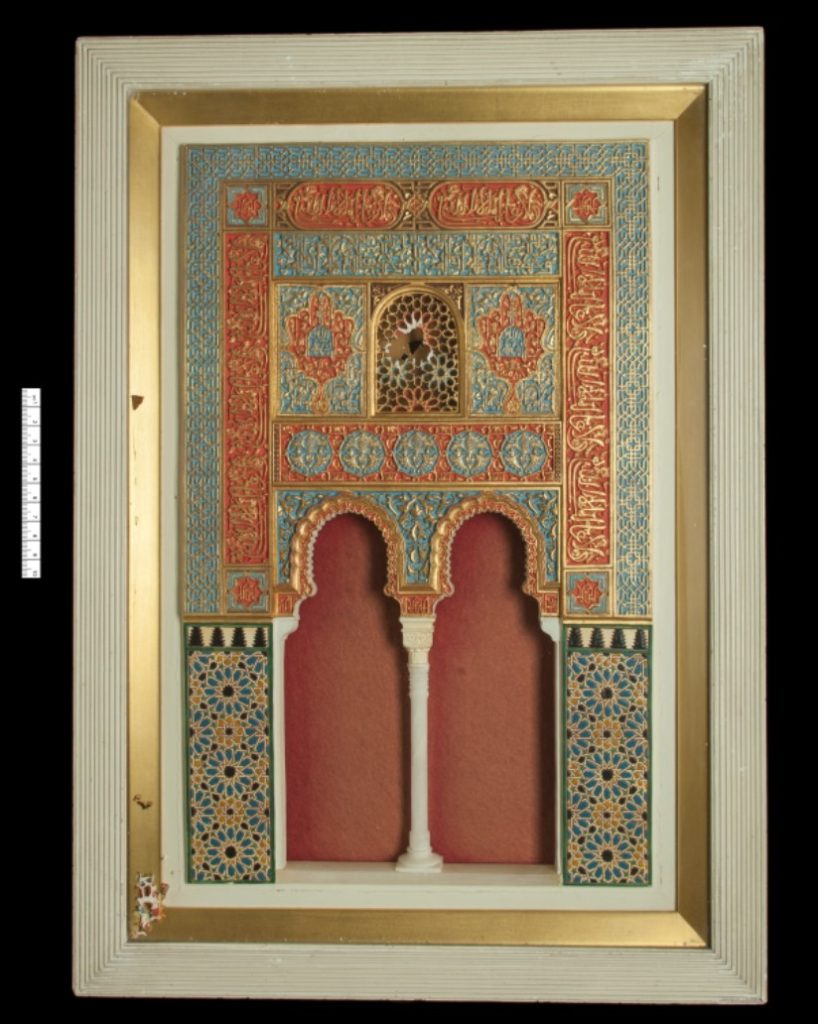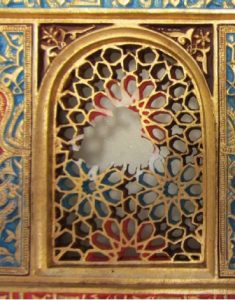February ’19
Islamic Maquette
February’s ‘Object of the Month’ is an Islamic Maquette from the Oriental Museum in Durham.

The maquette is one of a pair acquired from the estate of Professor Humphrey-Greg; each pictures a different archway from the Alhambra. It represents a double archway carved into plaster, gilded and coloured with pigment, and includes a marble pillar.
The maquette represents an archway within the Alhambra, an Islamic style palace complex that has undergone fairly continuous extension and rebuilding. The pillar is readily identifiable as Nasrid in style. Though the small scale does not allow full detail to be captured, the essence of the ataurique pattern with hints of the ribbed or dentated decoration that the original bears. In the 19th century, a new appreciation for Moorish heritage resulted in the production of maquettes, many similar enough to fall into one broader category; wall-mounted maquettes.

The maquettes were typically sold as souvenir items for tourists. It then serves as a social record of 19th century vacationing. The focus of 19th century maquettes on the Alhambra reflects the renewed interest in Spain Moorish past following the rebuilding of the Alhambra after an earthquake in 1821.

The Alhambra is an example of Moorish architecture at its zenith. As the Alhambra is in a tectonically active region, historic maquettes of the detail help preserve the heritage of Spain’s past. Many of the maquettes are not damaged in in poor repair. As the oriental museum examples are in remarkable condition, their importance is elevated.
Conservation

As part of the decorative plaster had been damaged it was important to be able to access the front of the maquette in order to assess the damage and restore the area if necessary. Therefore, the paper covering the back of the maquette, which detailed who framed the piece and was seen as an important aspect of the objects history, was carefully removed using an appropriate solvent gel in order to access the interior.

As the paper would be reattached to the frame once treatment of the plaster had been completed, it was decided to attach a backing material in order to prevent further deterioration. Previous damage to the paper had been caused by puncturing, so the paper was backed onto acid free card, which would provide stability and support. Furthermore the exterior portion of the paper was covered in Japanese tissue in order to help prevent further damage to the already fragile surface.

Once the frame had been removed the damaged plaster could be examined and a treatment proposed. The surface pigments of the damaged section were found to be incredibly powdery and fragile and so consolidation was found appropriate in order to prevent loss while reconstruction occurred.

The pigments were treated using an appropriate consolidant applied with an airbrush in order to achieve an even coverage. Once this had been completed the damaged plaster could be reconstructed; the plaster fragments were adhered using suitable adhesive and were maneuvered into position using vacuum tweezers which allowed for precision and care.

Finally the red felt, which had faded, was removed following a discussion with the Oriental Museum and a replacement piece was applied in order to restore the aesthetics of the maquette. The original felt was retained and will be stored with the object as it provides information about the object’s history.

Stay tuned for next
Stay tuned for next month’s object!
